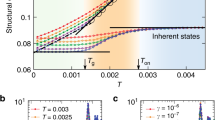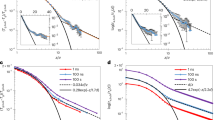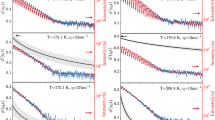Abstract
Glass formation is encountered in diverse materials. Experiments have revealed that the dynamic relaxation spectra of supercooled liquids generically become asymmetric near the glass transition temperature Tg, where an extended power law emerges at high frequencies. The microscopic origin of this ‘wing’ remains unknown, and has so far been inaccessible to simulations. Here we develop a novel computational approach and study the equilibrium dynamics of model supercooled liquids near Tg. We demonstrate the emergence of a power-law wing in the numerical spectra, which originates from relaxation at rare, localized regions over broadly distributed timescales. We rationalize the asymmetric shape of the relaxation spectra by constructing an empirical model associating heterogeneous activated dynamics with dynamic facilitation, which are the two minimal physical ingredients revealed by our simulations. Our work offers a glimpse into the molecular motion responsible for glass formation at relevant experimental conditions.
This is a preview of subscription content, access via your institution
Access options
Access Nature and 54 other Nature Portfolio journals
Get Nature+, our best-value online-access subscription
$29.99 / 30 days
cancel any time
Subscribe to this journal
Receive 12 print issues and online access
$209.00 per year
only $17.42 per issue
Buy this article
- Purchase on Springer Link
- Instant access to full article PDF
Prices may be subject to local taxes which are calculated during checkout




Similar content being viewed by others
Data availability
Source data are provided with this paper. The data that support the findings of this study are available from the corresponding author upon reasonable request.
Code availability
The codes used in this study are available from the corresponding author upon reasonable request.
References
Berthier, L. & Biroli, G. Theoretical perspective on the glass transition and amorphous materials. Rev. Mod. Phys. 83, 587 (2011).
Schmidtke, B., Petzold, N., Kahlau, R., Hofmann, M. & Rössler, E. A. From boiling point to glass transition temperature: transport coefficients in molecular liquids follow three-parameter scaling. Phys. Rev. E 86, 041507 (2012).
Lunkenheimer, P., Schneider, U., Brand, R. & Loid, A. Glassy dynamics. Contemp. Phys. 41, 15–36 (2000).
Körber, T., Stäglich, R., Gainaru, C., Böhmer, R. & Rössler, E. A. Systematic differences in the relaxation stretching of polar molecular liquids probed by dielectric vs magnetic resonance and photon correlation spectroscopy. J. Chem. Phys. 153, 124510 (2020).
Schmidtke, B., Petzold, N., Kahlau, R. & Rössler, E. A. Reorientational dynamics in molecular liquids as revealed by dynamic light scattering: from boiling point to glass transition temperature. J. Chem. Phys. 139, 084504 (2013).
Gainaru, C., Kahlau, R., Rössler, E. A. & Böhmer, R. Evolution of excess wing and β-process in simple glass formers. J. Chem. Phys. 131, 184510 (2009).
Flämig, M., Hofmann, M., Fatkullin, N. & Rössler, E. A. NMR relaxometry: the canonical case glycerol. J. Phys. Chem. B 124, 1557–1570 (2020).
Hecksher, T. et al. Toward broadband mechanical spectroscopy. Proc. Natl Acad. Sci. USA 114, 8710–8715 (2017).
Schneider, U., Brand, R., Lunkenheimer, P. & Loidl, A. Excess wing in the dielectric loss of glass formers: a Johari-Goldstein β relaxation? Phys. Rev. Lett. 84, 5560–5563 (2000).
Lunkenheimer, P., Wehn, R., Riegger, T. & Loidl, A. Excess wing in the dielectric loss of glass formers: further evidence for a β-relaxation. J. Non Cryst. Solids 307-310, 336–344 (2002).
Dixon, P. K., Wu, L., Nagel, S. R., Williams, B. D. & Carini, J. P. Scaling in the relaxation of supercooled liquids. Phys. Rev. Lett. 65, 1108–1111 (1990).
Leheny, R. L. & Nagel, S. R. Dielectric susceptibility studies of the high-frequency shape of the primary relaxation in supercooled liquids. J. Non Cryst. Solids 235-237, 278–285 (1998).
Menon, N. et al. Wide-frequency dielectric susceptibility measurements in glycerol. J. Non Cryst. Solids 141, 61–65 (1992).
Menon, N. & Nagel, S. R. Evidence for a divergent susceptibility at the glass transition. Phys. Rev. Lett. 74, 1230–1233 (1995).
Wu, L. Relaxation mechanisms in a benzyl chloride–toluene glass. Phys. Rev. B 43, 9906–9915 (1991).
Ngai, K. L. & Paluch, M. Classification of secondary relaxation in glass-formers based on dynamic properties. J. Chem. Phys. 120, 857–873 (2004).
Blochowicz, T., Tschirwitz, C., Benkhof, S. & Rössler, E. A. Susceptibility functions for slow relaxation processes in supercooled liquids and the search for universal relaxation patterns. J. Chem. Phys. 118, 7544–7555 (2003).
Bauer, T., Lunkenheimer, P., Kastner, S. & Loidl, A. Nonlinear dielectric response at the excess wing of glass-forming liquids. Phys. Rev. Lett. 110, 107603 (2013).
Duvvuri, K. & Richert, R. Dielectric hole burning in the high frequency wing of supercooled glycerol. J. Chem. Phys. 118, 1356–1363 (2003).
Lunkenheimer, P., Wehn, R., Schneider, U. & Loidl, A. Glassy aging dynamics. Phys. Rev. Lett. 95, 055702 (2005).
Diezemann, G., Mohanty, U. & Oppenheim, I. Slow secondary relaxation in a free-energy landscape model for relaxation in glass-forming liquids. Phys. Rev. E 59, 2067–2083 (1999).
Domschke, M., Marsilius, M., Blochowicz, T. & Voigtmann, T. Glassy relaxation and excess wing in mode-coupling theory: the dynamic susceptibility of propylene carbonate above and below Tc. Phys. Rev. E 84, 031506 (2011).
Sethna, J. P., Shore, J. D. & Huang, M. Scaling theory for the glass transition. Phys. Rev. B 44, 4943–4959 (1991).
Stevenson, J. D. & Wolynes, P. G. A universal origin for secondary relaxations in supercooled liquids and structural glasses. Nat. Phys. 6, 62–68 (2010).
Viot, P., Tarjus, G. & Kivelson, D. A heterogeneous picture of α relaxation for fragile supercooled liquids. J. Chem. Phys. 112, 10368–10378 (2000).
Chamberlin, R. V. Mesoscopic mean-field theory for supercooled liquids and the glass transition. Phys. Rev. Lett. 82, 2520–2523 (1999).
Dyre, J. C. & Schrøder, T. B. Universality of a.c. conduction in disordered solids. Rev. Mod. Phys. 72, 873–892 (2000).
Berthier, L. & Garrahan, J. P. Numerical study of a fragile three-dimensional kinetically constrained model. J. Phys. Chem. B 109, 3578–3585 (2005).
Ninarello, A., Berthier, L. & Coslovich, D. Models and algorithms for the next generation of glass transition studies. Phys. Rev. X 7, 021039 (2017).
Berthier, L., Charbonneau, P., Ninarello, A., Ozawa, M. & Yaida, S. Zero-temperature glass transition in two dimensions. Nat. Commun. 10, 1508 (2019).
Berthier, L. et al. Configurational entropy measurements in extremely supercooled liquids that break the glass ceiling. Proc. Natl Acad. Sci. USA 114, 11356–11361 (2017).
Berthier, L., Flenner, E., Fullerton, C. J., Scalliet, C. & Singh, M. Efficient swap algorithms for molecular dynamics simulations of equilibrium supercooled liquids. J. Stat. Mech. 2019, 064004 (2019).
Yu, H.-B., Richert, R. & Samwer, K. Structural rearrangements governing Johari-Goldstein relaxations in metallic glasses. Sci. Adv 3, e1701577 (2017).
Illing, B. et al. Mermin–Wagner fluctuations in 2D amorphous solids. Proc. Natl Acad. Sci. USA 114, 1856–1861 (2017).
Flenner, E. & Szamel, G. Fundamental differences between glassy dynamics in two and three dimensions. Nat. Commun. 6, 7392 (2015).
Berthier, L. & Ediger, M. D. How to ‘measure’ a structural relaxation time that is too long to be measured? J. Chem. Phys. 153, 044501 (2020).
Chandler, D. & Garrahan, J. P. Dynamics on the way to forming glass: bubbles in space-time. Annu. Rev. Phys. Chem. 61, 191–217 (2010).
Keys, A. S., Hedges, L. O., Garrahan, J. P., Glotzer, S. C. & Chandler, D. Excitations are localized and relaxation is hierarchical in glass-forming liquids. Phys. Rev. X 1, 021013 (2011).
Vogel, M. & Glotzer, S. C. Spatially heterogeneous dynamics and dynamic facilitation in a model of viscous silica. Phys. Rev. Lett. 92, 255901 (2004).
Dyre, J. C. Master-equation appoach to the glass transition. Phys. Rev. Lett. 58, 792–795 (1987).
Bouchaud, J.-P. Weak ergodicity breaking and aging in disordered systems. J. Phys. I 2, 1705–1713 (1992).
Rehwald, C., Rubner, O. & Heuer, A. From coupled elementary units to the complexity of the glass transition. Phys. Rev. Lett. 105, 117801 (2010).
Rehwald, C. & Heuer, A. How coupled elementary units determine the dynamics of macroscopic glass-forming systems. Phys. Rev. E 86, 051504 (2012).
Arkhipov, V. I. & Baessler, H. Random-walk approach to dynamic and thermodynamic properties of supercooled melts. 1. Viscosity and average relaxation times in strong and fragile liquids. J. Phys. Chem. 98, 662–669 (1994).
Scalliet, C., Guiselin, B. & Berthier, L. Excess wings and asymmetric relaxation spectra in a facilitated trap model. J. Chem. Phys. 155, 064505 (2021).
Xia, X. & Wolynes, P. G. Microscopic theory of heterogeneity and nonexponential relaxations in supercooled liquids. Phys. Rev. Lett. 86, 5526–5529 (2001).
van Meel, J. A., Filion, L., Valeriani, C. & Frenkel, D. A parameter-free, solid-angle based, nearest-neighbor algorithm. J. Chem. Phys. 136, 234107 (2012).
Schrøder, T. B., Sastry, S., Dyre, J. C. & Glotzer, S. C. Crossover to potential energy landscape dominated dynamics in a model glass-forming liquid. J. Chem. Phys. 112, 9834–9840 (2000).
Götze, W. Complex Dynamics of Glass-Forming Liquids: A Mode-Coupling Theory Vol. 143 (Oxford Univ. Press, 2009).
Acknowledgements
We thank G. Biroli, M. Ediger and J. Kurchan for discussions, and S. Nagel for detailed explanations about the experiments. Some simulations were performed at MESO@LR platform at the University of Montpellier. This work was supported by a grant from the Simons Foundation (no. 454933; L.B.), the European Research Council under the EU’s Horizon 2020 programme via grant no. 740269 (C.S.), a Herchel Smith Postdoctoral Research Fellowship (C.S.), a Ramon Jenkins Research Fellowship from Sidney Sussex College, Cambridge (C.S.), and Capital Fund Management - Fondation pour la Recherche (B.G.).
Author information
Authors and Affiliations
Contributions
B.G., C.S. and L.B. designed the research. B.G. and C.S. carried out the simulations. B.G, C.S. and L.B. analysed the data and wrote the paper.
Corresponding author
Ethics declarations
Competing interests
The authors declare no competing interests.
Peer review
Peer review information
Nature Physics thanks Reiner Zorn, Thomas Voigtmann and the other, anonymous, reviewer(s) for their contribution to the peer review of this work.
Additional information
Publisher’s note Springer Nature remains neutral with regard to jurisdictional claims in published maps and institutional affiliations.
Supplementary information
Supplementary Information
Supplementary Sections I and II and Figs. 1–4.
Source data
Source Data Fig. 1
The {x, y} data for Fig. 1a–c.
Source Data Fig. 3
The {x, y} data for Fig. 3.
Source Data Fig. 4
The {x, y} data for Fig. 4c.
Rights and permissions
About this article
Cite this article
Guiselin, B., Scalliet, C. & Berthier, L. Microscopic origin of excess wings in relaxation spectra of supercooled liquids. Nat. Phys. 18, 468–472 (2022). https://doi.org/10.1038/s41567-022-01508-z
Received:
Accepted:
Published:
Issue Date:
DOI: https://doi.org/10.1038/s41567-022-01508-z
This article is cited by
-
Probing excitations and cooperatively rearranging regions in deeply supercooled liquids
Nature Communications (2023)
-
Emergence of equilibrated liquid regions within the glass
Nature Physics (2023)
-
Visualizing slow internal relaxations in a two-dimensional glassy system
Nature Physics (2023)
-
Modern computational studies of the glass transition
Nature Reviews Physics (2023)
-
A wing explained
Nature Physics (2022)



